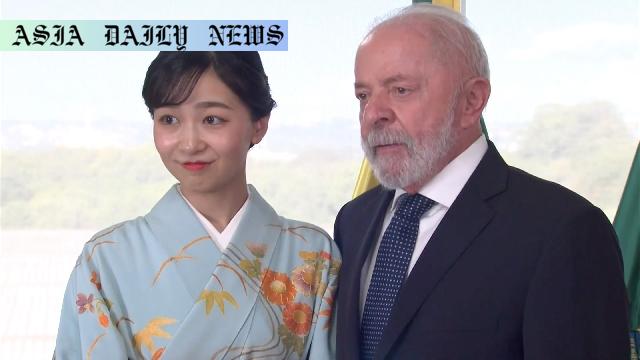Princess Kako: Honoring 130 years of Japan-Brazil relations in Brazil.
Princess Kako pays a courtesy call on Brazil’s President Lula in Brasilia.
She attended a ceremony marking 130 years of Japan-Brazil relations.
Princess Kako expressed hopes for deepening bilateral ties.

Princess Kako’s Courtesy Call on Brazilian Leadership
Japan’s Princess Kako, during her official visit to Brazil, reinforced the long-standing ties between Japan and Brazil through a courtesy visit to Brazilian President Luiz Inacio Lula da Silva on Wednesday. Visiting the presidential office in Brasilia, the Princess shared her gratitude for Brazil’s warm reception, furthering mutual respect and understanding between the two nations.
President Lula recalled his state visit to Japan earlier in March, reflecting on the kindness and hospitality extended by Emperor Naruhito. Such exchanges not only highlight the friendly rapport between the countries’ leaders but also symbolize a deeper bond extending well into their shared histories.
Commemorating 130 Years of Diplomatic Relations
The Princess participated in a significant event at Brazil’s Congress, commemorating the 130th anniversary of diplomatic relations between the two countries. Japanese-Brazilian diplomatic ties have been instrumental not only in fostering economic and trade relations but also in enriching cultural and interpersonal exchanges. The Princess highlighted her desire for these ties to remain strong and continue fostering mutual growth.
Japan and Brazil share a unique historical connection, with a significant number of Japanese immigrants contributing to Brazil’s diverse cultural tapestry. Events like this reaffirm the countries’ commitment to honoring their past and expanding future collaborations.
Future Plans and Symbolic Visits
Princess Kako, set to visit the iconic Mount Corcovado on Friday, will also take in Rio de Janeiro’s famous landmark, the Christ the Redeemer statue. Her itinerary symbolizes an appreciation for Brazil’s cultural and natural heritage, further cementing the people-to-people bond between the countries. These gestures not only honor the historical friendship but also pave the way for strengthened partnerships and deeper mutual respect.
The visit underscores the ongoing story of two nations working together, showcasing a shared vision for mutual prosperity and cultural richness. By celebrating their 130-year milestone, Japan and Brazil exemplify how longstanding partnerships can thrive and evolve amid global interconnectedness.
Commentary
The Significance of Princess Kako’s Visit
Princess Kako’s visit to Brazil isn’t merely a ceremonial gesture; it’s a deeply symbolic event that represents the robust relationship between Japan and Brazil, one that has grown steadily over the past 130 years. By engaging directly with Brazil’s leadership and participating in commemorative events, the Princess reaffirms the strong cultural and historical ties shared by both nations.
Such gestures underscore the importance of maintaining and nurturing bilateral relationships in an increasingly interconnected world. By focusing on history and shared values, Princess Kako highlights how partnerships between nations can promote better understanding, economic opportunities, and mutual respect across cultures.
The Legacy of Japan-Brazil Relations
The 130-year history of Japan-Brazil relations is built on a foundation of mutual respect and collaboration. Over time, these bonds have been enriched by significant Japanese immigration to Brazil and cultural exchanges. Events such as the Princess’s visit shine a light on these contributions, showing how historical relationships can evolve to address contemporary issues and foster deeper socio-economic and cultural connections.
Looking Towards the Future
With her remarks emphasizing the hope for stronger and lasting ties, Princess Kako sets a hopeful tone for what lies ahead in Japan-Brazil relations. As modern challenges such as globalization and economic uncertainty unfold, her vision of collaboration reminds us of the deep trust and affection that countries can cultivate over time. It’s a testament to the power of diplomacy and cultural exchange as tools for fostering peace and prosperity worldwide.


